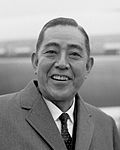From Wikipedia, the free encyclopedia
Japanese House of Councillors election, 1971|
|
|
|
|
First party
|
Second party
|
Third party
|
|
|

|
|

|
| Leader
|
Eisaku Satō
|
Tomomi Narita
|
Yoshikatsu Takeiri
|
| Party
|
LDP
|
Socialist
|
Komeito
|
| Seats after
|
137
|
66
|
22
|
| Seat change
|
 3 3
|
 1 1
|
 2 2
|
| Popular vote
|
17,759,395
|
8,494,264
|
5,626,293
|
| Percentage
|
44,5%
|
21.3%
|
14.1%
|
| Swing
|
 2.2% 2.2%
|
 2.5% 2.5%
|
 1.4% 1.4%
|
|
|
|
Fourth party
|
Fifth party
|
|
|
|
|
| Leader
|
Kasuga Ikkō
|
Sanzō Nosaka
|
| Party
|
Democratic Socialist
|
JCP
|
| Seats after
|
13
|
10
|
| Seat change
|
 3 3
|
 3 3
|
| Popular vote
|
2,441,509
|
3,219,307
|
| Percentage
|
6.1%
|
8.1%
|
| Swing
|
 0.1% 0.1%
|
 3.1% 3.1%
|
|
|
House of Councillors elections were held in Japan on 27 June 1971,[1] electing half the seats in the House. The Liberal Democratic Party won the most seats.
Results
| Party
|
Constituency
|
National
|
Total
seats
|
| Votes
|
%
|
Seats
|
Votes
|
%
|
Seats
|
| Liberal Democratic Party |
17,727,263 |
44.0 |
41 |
17,759,395 |
44.5 |
21 |
62
|
| Japan Socialist Party |
12,597,644 |
31.2 |
28 |
8,494,264 |
21.3 |
11 |
39
|
| Japanese Communist Party |
4,878,570 |
12.1 |
1 |
3,219,307 |
8.1 |
5 |
6
|
| Democratic Socialist Party |
1,919,643 |
4.8 |
2 |
2,441,509 |
6.1 |
4 |
6
|
| Komeitō |
1,391,855 |
3.5 |
2 |
5,626,293 |
14.1 |
8 |
10
|
| Other parties |
74,739 |
0.2 |
0 |
48,300 |
0.1 |
0 |
0
|
| Independents |
1,741,201 |
4.3 |
1 |
2,342,517 |
5.9 |
1 |
2
|
| Invalid/blank votes |
|
- |
- |
|
- |
- |
-
|
| Total |
40,330,916 |
100 |
75 |
39,931,584 |
100 |
50 |
125
|
| Source: Ministry of Internal Affairs and Communications
|
References



